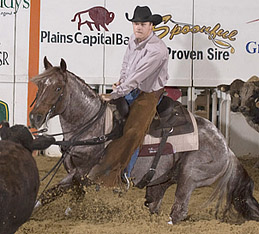 I have always been intrigued by horses that don’t fit neatly into the category of roan as described by the American Quarter Horse Association, The Jockey Club, or the Arabian Horse Registry of America. Often these horses are not related to roan horses, yet their coats are mixed with white hairs typically around the barrel, at the flanks, and/or at the base of the tail. Sometimes, as in the case of the legendary running champion Go Man Go (photo), they are registered as roans. Most often, as in the case of all-time leading cutting sire High Brow Cat, they are registered as a solid color horse.
I have always been intrigued by horses that don’t fit neatly into the category of roan as described by the American Quarter Horse Association, The Jockey Club, or the Arabian Horse Registry of America. Often these horses are not related to roan horses, yet their coats are mixed with white hairs typically around the barrel, at the flanks, and/or at the base of the tail. Sometimes, as in the case of the legendary running champion Go Man Go (photo), they are registered as roans. Most often, as in the case of all-time leading cutting sire High Brow Cat, they are registered as a solid color horse.
“Roaning” is a common term for this coat pattern, although The Lyons Press Horseman’s Dictionary refers to it as “rabicano,” and defines it as “a coat color in which a few, scattered white hairs appear amid a darker-colored background, usually on the hindquarters and dock.”
Roan, as defined by AQHA, is a “more or less uniform mixture of white with (red, black or bay base color) hairs over a large portion of the body, but usually darker on the head and lower legs…”
The difference between rabicano and true roan is that in the true roan the color is evenly distributed over the entire body, often with the exception of the head and lower legs, while rabicano roaning varies in intensity, sometimes spreads with age, and is usually limited to barrel and hindquarters. Rabicanos also often have “skunk or coon” tails, while true roans do not.
 Having pointed out the differences, I should add that rabicano can appear in any base color (not just red, black and bay), including true roan and gray. This can produce some especially flashy coats, such as that of Metallic Cat (photo), 2008 NCHA Open Futurity champion, who is a red roan with white hair at the base of his tail, which could be the result of rabicano over roan.
Having pointed out the differences, I should add that rabicano can appear in any base color (not just red, black and bay), including true roan and gray. This can produce some especially flashy coats, such as that of Metallic Cat (photo), 2008 NCHA Open Futurity champion, who is a red roan with white hair at the base of his tail, which could be the result of rabicano over roan.
Metallic Cat is sired by High Brow Cat, a chestnut with rabicano markings, and out of Chers Shadow, a Peptoboonsmal daughter, who is out of a Smart Little Lena daughter. Peptoboonsmal is a roan, while Smart Little Lena is a solid chestnut whose offspring sometimes have “coon” tails and other rabicano characteristics.
Because Royal King is the sire of Smart Little Lena’s dam and Smart Little Lena is the sire of High Brow Cat’s dam, Metallic Cat’s pedigree would seem to demonstrate an interesting theory about the source of rabicano coats in today’s cutting horses.
In a recent conversation with Quarter Horse pedigree expert Jim Ware, I asked his thoughts on the subject of rabicano coloring and cutting horse pedigrees. “I can’t prove it, but I think it goes back to Royal King,” said Ware, who over 40-plus years as breeder, auctioneer and bloodstock consultant, has scrutinized tens of thousands of horses and their pedigrees. “Not through his sire, King, but possibly through his dam.”
Rocket Laning, Royal King’s dam, was a sorrel foaled in 1937, and the color of her sire and dam are not documented.
Ware also pointed out that Royal King offspring were especially noted for two attributes: their cow sense and their white markings. As it happens, the rabicano trait, which is thought to be dominant, is often associated with white markings on the face and legs, and some researchers suspect that the white hairs of rabicano patterns could be rooted in unpigmented skin cells, in the same way as the hair in blazes, stars, stockings and other white markings.
What about Go Man Go, who seldom passed his rabicano characteristics to his offspring? His sire was the thoroughbred Top Deck, while his dam was a Quarter Horse sired by the thoroughbred Very Wise, and few of the mares that were bred to him were closely related to him. By contrast, the offspring of Smart Little Lena and High Brow Cat are often inbred within three generations, which could account for a greater number of rabicano offspring.
